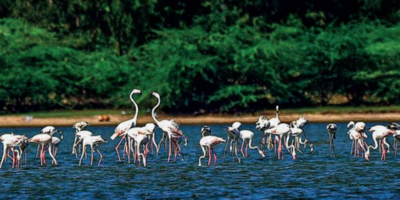Top Searches
- News
- City News
- chennai News
- Pulicat, potential tourism spot in Tamil Nadu, neglected
Pulicat, potential tourism spot in Tamil Nadu, neglected

A flock of greater flamingos that has arrived at the Pulicat Birds Sanctuary in Tiruvallur district
CHENNAI: A flock of nearly 700 greater flamingos has arrived at Pulicat bird’s sanctuary in Tiruvallur district, which in the next few months will also host several pelicans and ibises, among others.
Located about 70km from Chennai, the picturesque coastal with Dutch monuments, lagoons and shallow water spread for hundreds of acres — its fish and mud crabs are famous too — is a perfect weekend getaway, and ideal for water-based leisure activities, but has got almost no attention from tourism department.
The monuments are in a dilapidated condition and are crying for attention, and roads are full of craters and encroached upon by vendors. The scenic place has been reduced to a dust bowl.
Visitors are greeted by lungi-clad men howling ‘boat ride, boat ride’. The decade-old boat capsize incident in which 22 of a businessman’s family drowning is still fresh in memory, but several fishing boats roam around the lagoon carrying tourists and picnickers without any safety gear such as life jackets. Neither police, nor revenue or forest personnel are bothered about enforcing safety norms in the area. Bird researcher Vaithianathan Kannan said the place is of scientific interest to birders as rare pelagic species like Lesser noddy were recorded. The country’s second largest lagoon, Pulicate has a great potential for eco-tourism with focus on bird watching. During migratory season more than 50,000 birds can be found here, he said.
After they trained in bird watching, fishermen can be used as guides for the tourists. The boats should have safety paraphernalia while transporting the tourists. Safe eco-tourism programmes will help fishermen to get alternative employment and will improve their livelihood.
Tiruvallur collector Alby John said the administration was considering the restoration of eco-tourism in the district. “To begin with we want to attract the tourists to the four reservoirs in the district. The administration is also considering eco-tourism in Pulicat area with the consent of the forest department. Yet another plan, on farm tourism, is on the anvil.”
Located about 70km from Chennai, the picturesque coastal with Dutch monuments, lagoons and shallow water spread for hundreds of acres — its fish and mud crabs are famous too — is a perfect weekend getaway, and ideal for water-based leisure activities, but has got almost no attention from tourism department.
The monuments are in a dilapidated condition and are crying for attention, and roads are full of craters and encroached upon by vendors. The scenic place has been reduced to a dust bowl.
Visitors are greeted by lungi-clad men howling ‘boat ride, boat ride’. The decade-old boat capsize incident in which 22 of a businessman’s family drowning is still fresh in memory, but several fishing boats roam around the lagoon carrying tourists and picnickers without any safety gear such as life jackets. Neither police, nor revenue or forest personnel are bothered about enforcing safety norms in the area. Bird researcher Vaithianathan Kannan said the place is of scientific interest to birders as rare pelagic species like Lesser noddy were recorded. The country’s second largest lagoon, Pulicate has a great potential for eco-tourism with focus on bird watching. During migratory season more than 50,000 birds can be found here, he said.
After they trained in bird watching, fishermen can be used as guides for the tourists. The boats should have safety paraphernalia while transporting the tourists. Safe eco-tourism programmes will help fishermen to get alternative employment and will improve their livelihood.
Tiruvallur collector Alby John said the administration was considering the restoration of eco-tourism in the district. “To begin with we want to attract the tourists to the four reservoirs in the district. The administration is also considering eco-tourism in Pulicat area with the consent of the forest department. Yet another plan, on farm tourism, is on the anvil.”
FacebookTwitterLinkedinEMail
Start a Conversation
end of article

